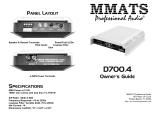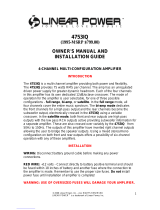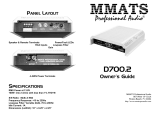Page is loading ...


Zapco Signal Processors
Welcome to the world of Zapco signal processing.
For over 25 years Zapco signal processors have been known as the
best that money can buy; a reputation that began with the PEQ in the late
70’s, then the PX (the worlds first true audiophile quality EQ / Crossover) in
the 80’s, and continues today with the SX-SL, the EQ-30, and DAII, the
combination that has set the standards for the 90’s and beyond.
Where will Zapco go next? Only time will tell. But, here’s one thing
you can count on…Zapco processing will continue to set the standards and
challenge the industry, with innovative new designs and superior
performance.
How superior is our performance? In a recent review of equalizers
from seven different companies, the article described the quality and sonic
performance of the Zapco unit as “Head and Shoulders” above the
competition.
So, once again, welcome to Zapco Processing.
1

Table of Contents
........................................................1 Zapco Signal Processors
Zapco Signal Processing.........................................................4
SymbiLink™
Balanced System...............................................5
Why Use The SymbiLink™ Balanced Signal System?.........6
Non-Linear Induced Distortions .............................................7
.......................................................8 Balanced or Unbalanced?
Setting the Gains in Your System ..........................................9
Cumulative Error ....................................................................10
.....................................................................................12 DAII-SL
EQ30-SL...................................................................................18
SX-SLII.....................................................................................26
SP7-SL.....................................................................................41
SP4-SL.....................................................................................45
..........................................................................................53 SEQ
SLX-4 .......................................................................................61
SLX-2 .......................................................................................74
2

The Zapco Processor Rack...................................................80
PSI-HPSL.................................................................................81
.........................................................................82 Manufacturing
Wire Size..................................................................................83
Technical Assistance.............................................................84
3

Zapco Signal Processing
What makes Zapco processors different from any other? Better
electronic design, combined with higher quality components inside,
accounts for much of the added clarity and the “openness” of sound with
Zapco processors. This also accounts for the superior imaging and the more
accurate sound stage with our processors.
Some have tried to duplicate the Zapco sound by modifying Hi-End
home gear for car use, but have met with limited success.
Why has Zapco succeeded? Because, right from the start, Zapco
recognized the two major problems of in-vehicle processing, and solved
them.
First: Power supply noise. Because a signal processor works with
such a low level of signal, any noise it creates can be easily induced into the
signal path. All power supplies create noise, even ours. Ours are just quieter
than the others. To make sure our processors don’t have power supply
noise, we took the power supply out. Starting with the PX, in the early 80’s,
every Zapco processor uses “phantom power”. If you are using a Zapco
amplifier, the processor will simply pull its power right from the amp. If not,
you can use the PSI-HPSL remote power supply. In either case, your Zapco
processor will have ±15 volts of clean, noise free power.
Why 15 volts, instead of 12 volts? Well, with 15 volts to work with, a
Zapco processor can put out as much as 16 volts RMS of signal. More than
any other preamp/processor. More signal means less noise.
Second: Signal loss and induced noise. An extremely important part
of the processing is the signal transmission system. The low level, non-
amplified, signal is always subject to induced noise and signal loss. It is
most vulnerable when being transferred between components; this is an
especially grave problem in the automotive environment because the
components are so far apart. In 1992 Zapco adopted the SymbiLink™
Balanced Line system for use in all its amplifiers and processors; this gives
Zapco the cleanest, quietest signal possible, while providing less distortion
and less signal loss.
4

SymbiLink™ Balanced System
The most natural configuration for an audio system in the
automobile places the signal source in the dash with the amplifiers located
some distance away, usually under the seat or in the trunk of the vehicle.
This arrangement dictates the necessity to make long runs of low level
signal cable usually from the front to the back of the car. The electrical
environment in an automobile is one that is inherently noisy and filled with
conditions that threaten to degrade signal fidelity at every turn. Capacitive
loading, (due to the long cable lengths), the potential for ground loops, and
alternator charging currents or currents generated by the amplifiers,
themselves are all factors that induce noise and distortion into the signal
cables. ZAPCO has made this technology available for your car. ZAPCO
engineers also discovered that the pulsating D.C. current in the automobile
chassis and amplifier power wiring caused a significant amount of low
frequency distortion. ZAPCO's SymbiLink™
balanced technology completely
eliminates this distortion.
SymbiLink™ components convert a standard unbalanced audio
signal into the fully balanced domain usually reserved for expensive
professional audio equipment found in recording studios or at your local
concert venue. After this conversion, the audio cabling becomes virtually
immune to electrical interference in the surrounding environment making it
much less susceptible to signal degradation over long cable runs. It is for
this reason that balanced signal cables are common in professional or
industrial applications.
Almost all Zapco Signal processors now employ the SymbiLink™
Balanced Line technology.
5

Why Use The SymbiLink™ Balanced Signal
System?
RCA style unbalanced cables have the following disadvantages:
1. Magnetic & electrostatic pickup. Noise and audio distortion can be
induced into the cable because the cable shield is also the audio (-)
connection.
2. Unbalanced cables are typically driven into very high impedance’s,
causing transient ringing. (See the drawing, below)
6

Non-Linear Induced Distortions
7

Balanced or Unbalanced?
Advantages
SymbiLink™ RCA
Balanced System Unbalanced System
1. High noise rejection. 1. Widely used and readily
2. Higher audio signal level (16V). available.
3. Higher S/N ratio. 2. The average customer
4. Improved stereo separation. and installer is more familiar
5. Improved T.H.D. with RCA type cables.
6. Low impedance (600 Ohms).
7. Easier to install, and cables can
be run anywhere.
8. Less expensive than high-end RCA cables.
Disadvantages
SymbiLink™ RCA
Balanced System Unbalanced System
1. Limited availability. 1. Poor noise rejection.
2. Most customers and installers are 2. Typically low audio
used to using RCA cables. signals (.5 — 1V).
3. Lower S/N ratio.
4. Susceptible to Non-linear
distortion.
5. RCA cables can pick up
alternator whine if by noise
radiating wires or equipment.
6. High impedance (20-100K).
7. Poorer stereo separation.
8. Even most high-end RCA
cables will usually pick up radiated
noise.
8

Setting the Gains in Your System
Proper gain setting is one of the most important factors in setting up
a stereo system; at the same time, it is the setting most often done wrong.
Turning up the gain of an amp is the very last thing you should ever do to a
system.
An amplifier is a step up transformer, Period. Anything you put in
gets boosted by a fixed factor. Music, hiss, or any other noise. It doesn’t
matter.
A large number of noise problems are simply a matter of improper
gain settings. The goal of gain setting is to achieve the maximum amount of
musical output from the amp while getting the least amount of hiss or noise
from the system; you are attempting to find the “maximum unclipped” signal
level.
The basic gain setting is very simple and requires no special tools.
Advanced settings can be made with a Digital Volt Meter, but these should
be left to an experienced installer. Whether you have a system with a deck
and an amp, or a system with a deck, line driver, eq, crossover, and amp,
the procedure always is the same.
Start at the deck! Not at the amp!
First, hook up the system with all gain controls at minimum (turn all
gain pots fully counter-clockwise with a small screwdriver). Then turn on the
head unit and turn up the volume. If you get clean sound, and more volume
than you want, you don’t need to make any adjustments. However, if you
turn up the volume and begin to hear distorted sound before it becomes
loud, you are clipping (distorting) the deck (probably a little over ¾ volume).
If this happens, turn the deck down just enough to hear clean sound again.
This is your “Maximum Unclipped” volume. Now move to the next
component in your system. With the deck playing at “maximum unclipped”
volume, adjust the gain of the next component in the system to its
“maximum unclipped” volume. If you adjust your gains this way, always
starting at the head unit and working down the line to the amp, you will get
the most performance out of your amp with the least unwanted noise.
You do not “feel” high volume sound in your ears, it’s distortion that
makes a system “uncomfortable”. Proper gain setting will allow the
maximum volume with the minimum distortion so you can turn the system
up till the windows rattle, and it will never sound “too loud”.
9

“Use Safe Sound”. Having properly set gains will allow you to
comfortably play the system at a much higher SPL, the fact that it is now
more comfortable to play at a higher SPL does not mean it is safer. The
functioning devices in your ear do not have very good pain receptors; even if
it does not “feel” like it hurts, excessively high SPL absolutely will damage
your hearing. So, please practice safe sound!
Cumulative Error
An issue that often is debated is at what level does distortion
become detectable to the human ear? Is there truly an audible difference
between a unit that measures .05% THD and one that measures .1% THD?
There are many who contend, with good cause, that distortion does not
become audible until the magnitude approaches 1% or more. Why do we go
to such great lengths in order to ensure the accuracy of each unit when
such minute differences are most likely inaudible?
The answer to this question underlies ZAPCO’s entire design
philosophy and is based on the simple concept of cumulative error. To
understand the point you must consider all the pieces of electronic
equipment that comprise the chain between the original performance and
your ears. From the microphone used to record the performance, to the
speakers used to reproduce it, the ultimate accuracy of the final output is
directly dependent on the accuracy of all of the pieces that comprise the
system. Given that this is not a perfect world, it is inevitable that each piece
of equipment will add some distortion or error to the original signal, and
signal degradation along this chain can be nothing but cumulative. It is the
cumulative error of the system as a whole of which we must be mindful.
From ZAPCO’s perspective, the idea that .1% THD, inaudible in and
of itself, is good enough, is unthinkable! If .002% THD is possible it is the
obligation of the manufacturer to do all that is feasible to attain that
maximum level of performance.
10

The Zapco Processors
11

DAII-SL
Specifications
Maximum balanced output level 8 Volts, R.M.S.*
Maximum unbalanced output level 4 Volts, R.M.S.
Indicators
Six: Three error, input select,
zero bit detect, & power
Outputs Balanced & unbalanced RCA
Minimum output impedance 600 Ohms
Digital Input format AES/EBU, IEC 958, S/PDIF, &
EIAJ CP-340 digital audio
standards
Digital input type 44.1 or 48kHz, Coax or Toslink
Frequency response, DC – 20kHz
±.2dB
S/N ratio “A” weighted, Zero bits > 115dB
Separation @ 1KHz, “A” weighted > 105 dB
Current requirements 300 mA
Harmonic distortion < .001%
De-Jitter Two stage, VXO PLL
Dimensions 4.5”D x 6.9”W x 1”H
*Note: The DAII-SL can produce 18 volts RMS, but it is calibrated to 8 volts
RMS when the maximum digital waveform is applied.
12

What is the DAII-SL?
Because it is the first component in the ultimate signal processing
system, we present the DAII-SL first in this manual.
Why an outboard D/A converter if every deck already has one? It is
the only way to achieve the highest possible sound quality from a digital
source. Every head unit with a digital function (like a CD) must have a D/A in
order to work. The D/A in a head unit, though, is barely passable, for two
reasons. The first is size, the Zapco DAII circuit board is roughly the same
size as the average CD player’s board’ there simply isn’t room in most
decks for a converter of this caliber. The second is cost, an audiophile D/A
like the DAII costs three to four times as much to build as a typical CD deck.
Only those who demand the absolute finest sound quality will make the
investment for a truly accurate D/A. Those who do demand the very best,
will accept nothing else.
The DAII-SL can accept practically any format of signal. Provisions for
analog as well as optical or coaxial digital inputs are available. The analog
input is automatically selected when two seconds of zero bits are detected.
The zero bit detector is available for control of an external noise gate via an
optically isolated output. Internal mode switches configure the DAII-SL for
compatibility with a wide range of professional and consumer digital formats.
Unsurpassed in performance and features, the design incorporates two
stages of jitter removal, an 8X interpolating filter and a 64X fifth order Delta-
Sigma modulator. Dual Phase Locked Loops (PLL) are included to ensure
the complete removal of digital jitter. The second PLL is crystal stabilized to
provide perfect digital timing. A one bit differential DAC feeds balanced
analog output filters. This method of conversion eliminates temperature drift
and the need for laser trimmed resistors. Five precision voltage regulators
minimize crosstalk and ensure the purity of the conversion process. The
DAII-SL's dynamic range exceeds 107dB with a noise floor greater than —
115 dB. Total Harmonic Distortion measures less than an incredible
.0009%. Both RCA and SymbiLink™ balanced outputs are available at the
back of the sleek half-DIN chassis, providing the ultimate in flexibility.
The DAII-SL's optical, coaxial, and balanced analog inputs permit
integration into any high quality audio system. The DAII-SL has switch
configurable formats for AES/EBU, IEC 958, S/PDIF, & EIAJ CP-340 digital
audio standards.
13

What to Expect
You should expect to hear a more focused, yet broader image than
you’ve ever heard before. In addition, expect to notice a silky smoothness in
the upper high frequency range. First reports of listener’s experience with
the DAII-SL also included added detail, never heard before in the recording.
Key Features
• SymbiLink™ balanced input and output
• Optical, coax and analog inputs
• Ultra high signal to noise ratio greater than 115 dB
• Better than 105 dB separation
• De-Jitter / Re-clocking circuit
• Digital error status indicators
• Fully balanced, including output filters
• Zero bit detect output for triggering external noise gates
• Zero bit detect / automatic analog input selection
• Small, sleek 1/2 DIN chassis
• Quality Zapco construction
• Designed and built in the USA
14

Switch Settings
Z-Bit switch:
The DAII-SL has an output that indicates when it detects no audio
data on the CD. This output is useful to trigger external components such as
a noise gate. This output coincides with the front panel “Zero bit” LED. The
zero-bit out is an opto-isolated output. The state may be reversed with the
“Z-bit out” switch. (See the figure, “Switch Settings”)
Z-Bit mute:
The DAII-SL also has Z-Bit muting capability. When the DAII-SL
detects a zero bit condition, it can mute its outputs. This is enabled by the
“Z-Bit Mute” switch. See the figure “Switch Settings” This is useful if the CD
player outputs invalid data during pause or when switched to FM or AM
mode.
De-Jitter:
The “De-Jitter” switch enables or disables the De-Jitter Digital
Processor circuit. This circuit greatly improves the overall imaging and high
frequency “smoothness” of the system. You would never want to disable this
circuit unless:
1. Your CD transport is out of spec. and its clock rate is off more than
200 parts / million.
2. You wish to listen to 48kHz audio from DDS satellite or DAT and do
not have the correct crystal.
16

DAII-SL System Diagram
17

EQ30-SL
Specifications
Maximum balanced output level 16 Volts RMS
Maximum unbalanced output level 8 Volts RMS
Input impedance 3k Ohms
Minimum output impedance 600 Ohms
Filter center frequencies EIA standard
Frequency response, 5Hz — 20kHz
±.25dB
S/N ratio “A” weighted, EQ in > 110dB
Separation @ 1KHz, “A” weighted > 90 dB
Maximum boost / cut +12dB / -12dB
Harmonic distortion, EQ in < .003%
Current requirements 300 mA
Transient distortion, EQ in < .001%
Dimensions 6”D x 6.9”W x 1”H
18

What is the EQ30-SL?
The EQ30-SL is fully balanced, 30 band, graphic equalizer using
SymbiLink™ technology for ultra low distortion and superior signal to noise
ratio, making the EQ30-SL the highest quality third octave equalizer
available today.
The EQ30 has thirty 1/3 octave bands of ±12dB boost/cut
equalization. This type of equalization is often required if the listener desires
to correct the tonal balance of the car’s interior. The EQ30 allows the user to
fine-tune the system to correct acoustic problems or to simply make
adjustments to suit their own musical tastes. A front panel bypass switch
allows the listener to compare the changes made to the system. Front panel
clipping indicators indicate clipping at any point within the EQ30, including
the 1/3 octave filters. Often, incorrect adjustment of these types of
equalizers result in individual filter bands clipping without any external
indication. This problem is eliminated with a high headroom design and
“sense all” clipping indicators.
In the Zapco tradition, using surface mount technology and adhering
to an engineering philosophy to only build a product as large as it has to be,
the EQ30-SL comes in a very small Half Din chassis. A pair of these mono
units may be dash mounted in a single Din space allowing the user to tune
the system from the listening position.
A pair of EQ30-SL’s requires the use of the Zapco PSI-SL. This
power supply can power up to five SymbiLink™ processors.
19
/






